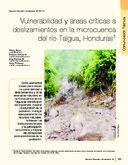| dc.contributor.author | Reyes, Wilmer | es_ES |
| dc.contributor.author | Jiménez Otárola, Francisco | es_ES |
| dc.contributor.author | Velásquez, Sergio | es_ES |
| dc.contributor.author | Faustino, Jorge | es_ES |
| dc.date.accessioned | 2015-03-19T22:16:26Z | |
| dc.date.available | 2015-03-19T22:16:26Z | |
| dc.date.issued | 2006-08 | |
| dc.identifier.issn | e-ISSN: 1659-1216 | es_ES |
| dc.identifier.uri | https://repositorio.catie.ac.cr/handle/11554/6927 | |
| dc.description.abstract | Se evaluó la vulnerabilidad y se determinaron áreas críticas a deslizamientos en la microcuenca del río Talgua, Honduras. La metodología incluyó el uso de sistemas de información geográfica y variables biofísicas, socioeconómicas y ambientales divididas en dos grandes grupos: vulnerabilidad global y factores críticos que aumentan la vulnerabilidad y el riesgo a deslizamientos. El 66 por ciento del área de la microcuenca presentó un nivel de vulnerabilidad alto, el 8 por ciento vulnerabilidad media y el 26 por ciento vulnerabilidad baja. Los componentes físicos, técnicos e institucionales de la vulnerabilidad global presentaron los valores más altos. Según los factores críticos propuestos, el 50 por ciento del área de la microcuenca presenta criticidad media, el 23 por ciento criticidad alta y el 16 por ciento criticidad baja. Al integrar espacialmente la vulnerabilidad y la criticidad en una relación ponderada (60:40), el 20 por ciento del área de la microcuenca presenta un nivel de riesgo bajo, el 27 por ciento nivel de riesgo medio y el 53 por ciento un nivel de riesgo alto. Como elementos claves para reducir la vulnerabilidad a deslizamientos y otras amenazas naturales se identificaron los siguientes: mejorar los niveles de educación, manejar adecuadamente los recursos naturales, fortalecer las instituciones locales y la participación comunitaria y mejorar las condiciones socioeconómicas. | es_ES |
| dc.description.abstract | Landslide vulnerability and critical areas were determined in Talgua River micro-watershed, Honduras. The methodology included the use of both GIS and variables related to global vulnerability and landslide risk critical factors. Variables evaluated involved three types: biophysical, socioeconomic and environmental. Results showed that 66 per cent of the micro-watershed had a high vulnerability level, 8 per cent mid vulnerability, and 26 per cent low vulnerability. The physical, technical, and institutional components of global vulnerability showed the highest values. As for critical factors, 50 per cent of the micro-watershed had a mid level of criticalness, 23 per cent a high level and 16 per cent a low level. Spatial combination of vulnerability and criticalness by a weighted relation (60:40) determined that 20 per cent of the micro-watershed had a low risk level, 27 per cent had a mid level, and 53 per cent had a high risk level. Key factors for reducing vulnerability to landslide and other natural threats were identified among them: improved education, improved natural resources management, strengthened local organizations and participation, and ameliorated socioeconomic conditions. | |
| dc.format.extent | 8 páginas | |
| dc.language.iso | es | es_ES |
| dc.publisher | CATIE, Turrialba (Costa Rica) | es_ES |
| dc.relation.ispartof | Recursos Naturales y Ambiente, número 48, páginas 103-110 | es_ES |
| dc.rights | info:eu-repo/semantics/openAccess | |
| dc.subject | CUENCAS HIDROGRAFICAS | es_ES |
| dc.subject | DESLIZAMIENTOS DE TIERRAS | es_ES |
| dc.subject | DESASTRES NATURALES | es_ES |
| dc.subject | INUNDACION | es_ES |
| dc.subject | FACTORES DE RIESGO | es_ES |
| dc.subject | HONDURAS | es_ES |
| dc.title | Vulnerabilidad y áreas críticas a deslizamientos en la microcuenca del río Talgua, Honduras | es_ES |
| dc.title.alternative | Landslide vulnerability and critical areas in Talgua River micro-watershed, Honduras | es_ES |
| dc.type | Artículo | es_ES |
| dc.creator.id | https://orcid.org/ 0000-0002-0361-496X | |
| dc.creator.id | http://orcid.org/0000-0002-2639-0583 | |


